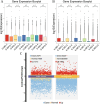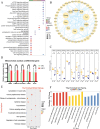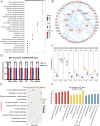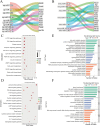Revealing gene expression links between milk fat globules and mammary glands in rodents via transcriptomics
- PMID: 40433461
- PMCID: PMC12106365
- DOI: 10.3389/fvets.2025.1555705
Revealing gene expression links between milk fat globules and mammary glands in rodents via transcriptomics
Abstract
Currently, most studies on lactation-related traits and gene expression rely on invasive techniques to obtain mammary tissue. These methods are not only difficult to perform but also limit the availability of samples. Therefore, this study aimed to utilize whole transcriptome sequencing to investigate the gene expression profiles of Golden hamsters (Gh, n = 5) and Kunming mice (Km, n = 5). It compared the transcriptome expression between milk fat globules (MFG) and the mammary gland (MG), identified candidate genes and pathways associated with lactation traits, and assessed the potential of MFG as an effective alternative to MG. The data showed that a total of 21,360 genes were identified in the Gh group, with 66.5% of the mRNAs showing no differential expression between MG and MFG. In the Km group, a total of 44,248 genes were identified, with non-differentially expressed genes (NDEGs) accounting for 58.8%. Additionally, the majority of ncRNA data consisted of NDEGs. In both groups, approximately 80% of miRNA data were NDEGs. Notably, the proportion of NDEGs in circRNA data approached 100%. Enrichment analysis revealed that NDEGs from both groups were significantly enriched in several pathways, including the MAPK signaling pathway, PI3K-Akt signaling pathway, JAK-STAT signaling pathway, and prolactin signaling pathway, all of which are closely associated with lactation traits and the lactation process. Furthermore, we identified various ncRNAs that regulate the expression of target genes either directly or indirectly, thereby influencing the lactation process. This study validates MFG as a reliable substitute for MG, with potential applications in improving dairy science. By identifying key genes and pathways, it provides new insights for optimizing genetic selection and breeding strategies. It also supports the improvement of dairy animal management practices.
Keywords: gene expression profiles; lactation traits; mammary gland; milk fat globules; whole-transcriptome sequencing.
Copyright © 2025 Jiang, Xu, Song, Liu, Cui, Li, Huang and Li.
Conflict of interest statement
The authors declare that the research was conducted in the absence of any commercial or financial relationships that could be construed as a potential conflict of interest.
Figures






Similar articles
-
Validation of RNA isolated from milk fat globules to profile mammary epithelial cell expression during lactation and transcriptional response to a bacterial infection.J Dairy Sci. 2012 Oct;95(10):6130-44. doi: 10.3168/jds.2012-5604. Epub 2012 Aug 23. J Dairy Sci. 2012. PMID: 22921620
-
Comparison of five different RNA sources to examine the lactating bovine mammary gland transcriptome using RNA-Sequencing.Sci Rep. 2014 Jul 8;4:5297. doi: 10.1038/srep05297. Sci Rep. 2014. PMID: 25001089 Free PMC article.
-
Transcriptome analysis of the mammary gland from GH transgenic goats during involution.Gene. 2015 Jul 10;565(2):228-34. doi: 10.1016/j.gene.2015.04.017. Epub 2015 Apr 10. Gene. 2015. PMID: 25865296
-
Leptin signaling promotes milk fat synthesis via PI3K/AKT/mTOR/SREBP1 in mammary gland of dairy cow.J Dairy Res. 2024 Nov;91(4):433-444. doi: 10.1017/S002202992500010X. Epub 2025 Mar 5. J Dairy Res. 2024. PMID: 40040580
-
Regulation and functional relevance of milk fat globules and their components in the mammary gland.Biosci Biotechnol Biochem. 2006 Sep;70(9):2019-27. doi: 10.1271/bbb.60142. Epub 2006 Sep 7. Biosci Biotechnol Biochem. 2006. Retraction in: Biosci Biotechnol Biochem. 2013;77(12):2013R3. PMID: 16960354 Retracted. Review.
References
LinkOut - more resources
Full Text Sources

